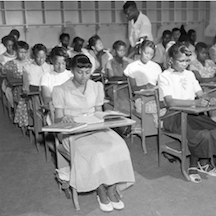 A draft of a new working paper by researchers at Duke University and the University of North Carolina at Chapel Hill finds that while racial segregation in the public school systems in North Carolina has been reduced, racial segregation within individual public schools remains high.
A draft of a new working paper by researchers at Duke University and the University of North Carolina at Chapel Hill finds that while racial segregation in the public school systems in North Carolina has been reduced, racial segregation within individual public schools remains high.
The authors state that “schools with large shares of Black or Hispanic students tend to have more segregated class assignment patterns. School segregation brings with it differences by race and ethnicity in the courses that students take, with White students more likely to be placed in advanced classes.”
The authors’ data shows that 40 percent of the racial segregation in the state’s public schools is due to segregation within individual schools. The authors also note that schools that have the highest levels of racial integration for the entire student body tend to have the highest levels of within-school segregation. Much of this within school segregation occurs because White students are far more likely than their Black or Hispanic peers to take advanced-level courses.
The research was led by Charles Clotfelter, the Z. Smith Reynolds Distinguished Professor of Public Policy Studies at Duke University. Coauthors are Helen Ladd and Mavzuna Turaeva of Duke University and Steven Hemelt of the University of North Carolina at Chapel Hill.











This story is old news. NPR did a show 15 years ago on Little Rock High (AK) that showed the historic civil rights battlefield school with white AP students and blacks in Home Ed. Gives us new news on this front, JBHE. You’re becoming the Journal of Captain Obvious.
While similar in-school racial segregation may not be something new, a study showing it is happening statewide in North Carolina is a lot different than examining the situation in one school in Arkansas. And regardless of whether it was true 15 years ago or not, the fact that it continues to occur – and on a large scale – is still newsworthy.